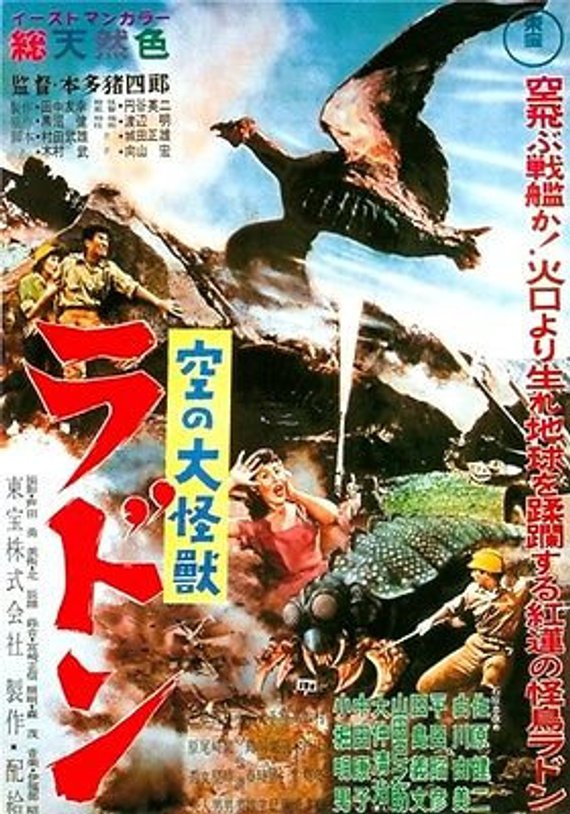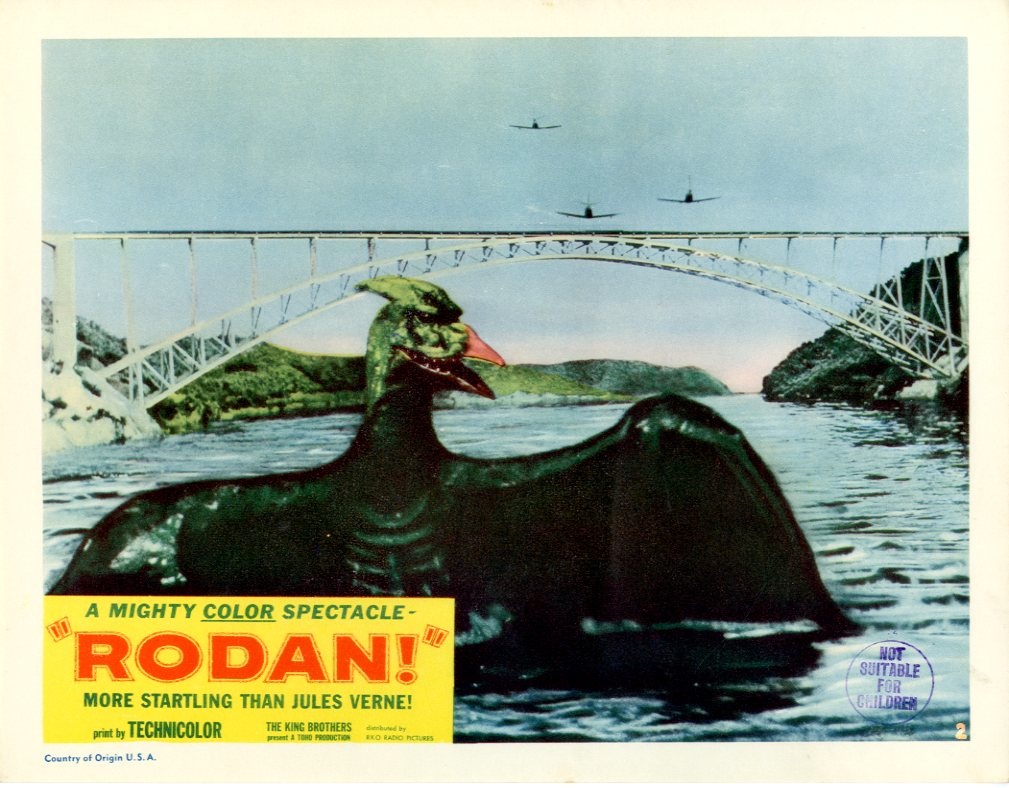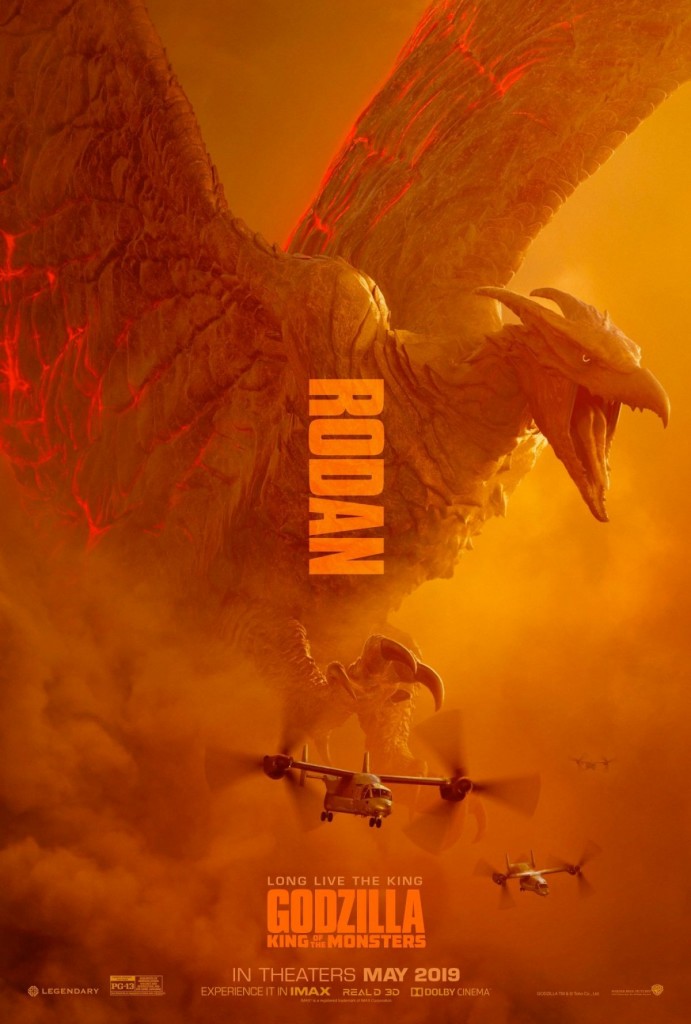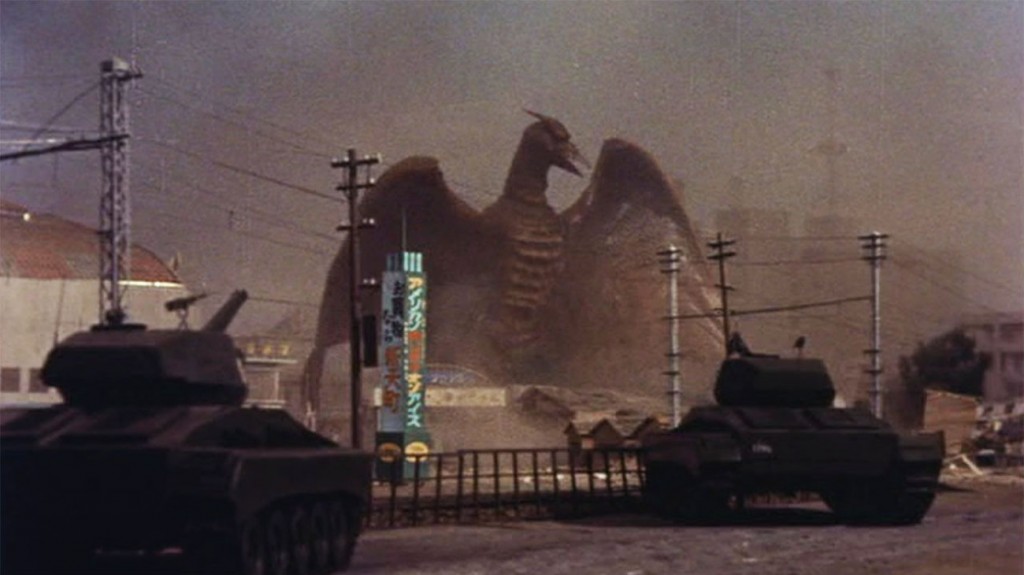Rodan, The 1956 Flying Monster Who Colorized the Godzilla-verse
The trailer for Godzilla: King of the Monsters, the direct sequel to the 2014 US Godzilla and the third installment in the Warner Bros. “Monsterverse” series after Kong: Skull Island, arrived earlier this week. It’s beautiful kaiju madness, even without Debussy’s dulcet tones rolling beneath it. King Ghidorah appears in all its auriferous splendor, charging into Godzilla in a jaw-dropping final shot meant to bring tears to my eyes. It succeeded. Our own Nick Ozment has some thoughts about it he put up yesterday which you should check out.
I’m tempted to proclaim the wonders of King Ghidorah, but I’ve already given the three-headed space dragon plenty of attention in a post about Ghidorah, The Three-Headed Monster, the 1964 film that’s essentially the template for the upcoming Godzilla movie. So as an alternate, I’m going to talk about the other monster who has money shots in the trailer: Rodan, one of the oldest of Toho Studio’s monsters. Specifically, I’m going to look at Rodan’s debut, a self-titled showstopper from 1956 and the first Toho kaiju film in color.
Sora no Daikaiju Radon (“The Giant Monster of the Sky, Rodan”), which Toho titled Rodan for US foreign sales to avoid confusion with the chemical element radon,* was released the year after the first Godzilla sequel, Godzilla Raids Again. The second go-around for Godzilla was financially successful, but not the earth-shaker of the original. Toho didn’t think there was more to mine from Godzilla and wouldn’t return to the Big G until King Kong vs. Godzilla eight years later. But Toho executives were willing to bet theatergoers would show up to see a destruction spectacle with an new type of monster … especially if was IN TECHNICOLOR! Or Eastmancolor.
Less than 10% of Japanese films in 1956 were in color, so opting to shoot a new kaiju film this way was a risk. But it also declared the project as a Big Damn Deal. Toho had only released their first color film earlier in the year, the fairy tale-inspired period piece The Legend of the White Serpent (Madame White Snake). The addition of color created challenges for effects director Eiji Tsubaraya and his team. Black and white allowed for more seamless opticals, and color added new concerns about proper lighting and model design. Tsubaraya never backed away from a challenge, and the effects in Rodan show how fast his team adapted to creating giant science-fiction mayhem. Only a year later, Tsubaraya and Co. would put on the spectacular color showcase of The Mysterians, which added the new dimension of shooting in anamorphic widescreen. (Rodan was shot flat in a 1.33 aspect ratio.)
Godzilla director Ishiro Honda was brought back to guide the new monster, which was a smart move after workman director Motoyoshi Oda provided workman direction for Godzilla Raids Again. From here on, Honda would be Toho’s top SF director, and nobody else would touch a giant monster film until Godzilla vs. Ebirah in 1966.
Rodan doesn’t hold up as a stark, emotional wrecking-ball like Godzilla. It isn’t as concerned with heavy themes; it wants to deliver thrills and scares. It’s still a masterpiece of the kaiju genre, and arguably the best “flying monster” movie ever made. We aren’t yet at the most colorful and strange stage of the Toho science-fiction film, but Rodan is masterful for ‘50s giant monster entertainment.
Honda handles the drama of the first half with an expert hand, and the devastation of the second half is a marvel to behold. The rampage of the Rodans (yes, there are two of them) is staggering in its scope. Because Rodan could also be portrayed using a prop rather than always a performer in a suit, the special effects team was able to vary the scale and detail of the models for greater realism.
 Rodan is often frightening in its early sections, where it resembles the big bug films of the US, particularly the super-ant classic Them! (1954). The movie opens at a coal mine near Mt. Aso, located on the southernmost island of Japan, Kyushu. A missing miner’s body is discovered in the tunnels, apparently murdered with a sharp object. When mine guards search the tunnels looking for another missing miner they suspect is behind the killing, they also die — dragged into underwater pools screaming in an unnerving sequence. The real killers are Meganuron, giant larva-like creatures released from eggs in the deepest tunnels. Something like a Horta, but Spock could never mind meld with these hungry nasties.
Rodan is often frightening in its early sections, where it resembles the big bug films of the US, particularly the super-ant classic Them! (1954). The movie opens at a coal mine near Mt. Aso, located on the southernmost island of Japan, Kyushu. A missing miner’s body is discovered in the tunnels, apparently murdered with a sharp object. When mine guards search the tunnels looking for another missing miner they suspect is behind the killing, they also die — dragged into underwater pools screaming in an unnerving sequence. The real killers are Meganuron, giant larva-like creatures released from eggs in the deepest tunnels. Something like a Horta, but Spock could never mind meld with these hungry nasties.
The Meganuron scenes are legitimately effective as horror movie material. Using a similar technique from Them!, the beasts are preceded by an eerie clicking and humming noise. The night attack on the miners’ homes and the pursuit down into the mine caverns contains some of the best suspense moments of Ishiro Honda’s career … and this is only a warm-up before the actual monsters arrive.
An earthquake strikes Mt. Aso and a huge section collapses. Shigeru Kawamura (Toho SF staple Kenji Sahara), a miner who vanished during the chase in the tunnels, is discovered stumbling around the crater in a catatonic state. While doctors try to get him to remember what he’s seen, two flying objects moving at supersonic speed start harassing the skies over Japan, China, and the Philippines. They even kill a couple picnicking on the slopes of Mt. Aso with a sonic boom.
When Shigeru recovers, he recalls the trauma that mentally paralyzed him. Down in the caverns of the volcano, he witnessed Rodan hatching and seeing the giant feasting on the Meganurons. And yes, we get to see this on screen, and it’s grotesque with a touch of a Lovecraftian nightmare. Scientists, led by Akihiko Hirata (Dr. Serizawa in Godzilla), recover part of the massive eggshell from the cavern to prove Shigeru’s story. After some analysis, the scientists announce to the Japanese Self-Defense Force what they’re facing.
Rodan — or the Rodans — are gigantic Pteranodon-like creatures with 270-foot wingspans. (The Japanese name Radon comes from a contraction of Pteranodon.) Why a winged dinosaur has grown to such colossal size and can jet around the world at supersonic speeds is never explained, but this is part of the bizarre magic of Japanese giant monsters. Kaijus are greater and stranger than prehistoric beasts or enlarged animals; they’re more like primordial demigods.
At this point, the original human drama at the mine has to be left behind, which is one reason Rodan is a lesser movie than Godzilla, which manages to keep its quartet of protagonists at the center of the action even with the shift to full monster destruction. It’s hard to feel too down about this, because what now takes place is pure cinema sensation.
JSDF jets fly in pursuit a Rodan to the tune of one of composer Akira Ifukube’s most thrilling marches, “Get Rodan!” The aerial duel is electrifying and concludes in the destruction of the huge Saikai Bridge, one of Eiji Tsubaraya’s most intricate models. The filmmakers of the upcoming 2019 Godzilla film have clearly paid attention to the aerial combat of this sequence, since the footage from the newest trailer shows Rodan executing similar moves against fighter planes.
The major VFX set-piece immediately follows when the Rodans land in Fukuoka, Kyushu’s largest city, and unleash a hurricane of devastation. Tanks and missile launchers hurl a barrage at the monsters, doing nothing but enlarging the near-total destruction of the city. The sequence is a departure from what Tsubaraya did in Godzilla, which was a slow and grim trudge of escalating horror. The Fukuoka attack is fast and kinetic, with smoke and debris flying into the sky and sides of buildings shredded off bit-by-bit in the unholy maelstrom from the monster’s wings. The high quality of the effects ensured this footage was recycled constantly during the low-cost 1970s films. One shot of a soldier trying to grip onto a tree before the winds carry him away is one of the most recognizable images from Toho’s kaiju films because of how often it was repeated. I think it even showed up in Kurosawa’s Ran.
Rodan still needs to have a finale with the death of the monsters — an obligatory move in the 1950s. After the city-leveling spectacle, anything was bound to be a touch disappointing. The JASDF finds the Rodans hiding in Mt. Aso’s crater, so they launch a massive rocket assault to trap them, eventually triggering an eruption. The miniature effects of the mountainsides blowing apart are superb (the volcano model was enormous, constructed to one third scale), but the explosions go on for so long it turns tiresome. Eiji Tsubaraya made a similar error with The Mysterians the next year, which has a climax of laser guns firing for an eternity. But the actual last moments of Rodan are touching, as one Rodan dies and the second chooses to perish with it among the lava flows rather than escape. The film takes a slow breath and Ifukube’s score turns to beautiful mourning. For Honda and Tsubaraya, monsters could be something more than monsters.
Rodan was a huge hit in Japan, dwarfing the receipts from Godzilla Raids Again and ensuring the continuation of the giant monster genre. This is where the true kaiju and science-fiction phase of Toho Studios starts. Rodan proved Godzilla wasn’t a standalone fluke; audiences wanted big monsters, and they wanted a variety of them.
Rodan was a success around the world as well, helping to keep up foreign demand for Toho’s product. The King Brothers released the English-language version, striking the prints through Technicolor’s labs, which is why they could brag about that on the posters. (Eastmancolor doesn’t have the same poster pizazz.) The dubbing is good, with George Takei featured, but the US version shears the running time by ten minutes and replaces parts of Ifukube’s music with dull library tracks, something that happened too often. A redundant voice-over from the POV of Shigeru was added, along with a three-minute prologue of stock footage to create a vague link between the Rodans’ re-awakening and nuclear testing in the Pacific. The changes add nothing to the story, but don’t catastrophically injure the movie’s entertainment value.
 Rodan the monster never received a standalone sequel, but it became one of the most popular supporting cast members of the Godzilla series. Rodan returned for Ghidorah, The Three-Headed Monster, where it was pitted against Godzilla for a good stretch of the film — until Mothra talks them both out of their petty brawling to go up against the New Jerk on the Block. The Rodan vs. Godzilla confrontations are amusing for how much Rodan turns into a joker who enjoys annoying Godzilla. During the showdown with King Ghidorah, Rodan executes a stunning U-turn maneuver to slam into Ghidorah and knock the dragon to the ground. Akira Ifukube provided Rodan with a new musical theme, adapting the main title cue of Varan (1957) with a soaring trumpet for one of the best musical motifs of the classic Toho days.
Rodan the monster never received a standalone sequel, but it became one of the most popular supporting cast members of the Godzilla series. Rodan returned for Ghidorah, The Three-Headed Monster, where it was pitted against Godzilla for a good stretch of the film — until Mothra talks them both out of their petty brawling to go up against the New Jerk on the Block. The Rodan vs. Godzilla confrontations are amusing for how much Rodan turns into a joker who enjoys annoying Godzilla. During the showdown with King Ghidorah, Rodan executes a stunning U-turn maneuver to slam into Ghidorah and knock the dragon to the ground. Akira Ifukube provided Rodan with a new musical theme, adapting the main title cue of Varan (1957) with a soaring trumpet for one of the best musical motifs of the classic Toho days.
Unfortunately, the Rodan costume and prop design was not as impressive the second time out, with a less prominent beak and generally friendlier appearance. The downward trend in Rodan’s design continued for its next two movies, Invasion of Astro-Monster (Monster Zero) (1965) and Destroy All Monsters (1968), with the head made puny with a turned-down beak that made the monster look too silly.
Rodan appeared in the Heisei Era in Godzilla vs. Mechagodzilla II (1993), the best movie of the second Godzilla series. Although having to play third-string to Godzilla and its robot counterpart, Rodan still makes an impression in a redesign as a smaller, more Pteranodon-like creature. In typical Heisei fashion, Rodan gets to have a beam weapon when it transforms through plot magic into Fire Rodan!
Rodan showed up once in the Millennium Era of films, when it appeared along with everyone else in Godzilla: Final Wars. Rodan’s design is almost identical to its 1956 version. It wrecks parts of New York City during the montage of monsters emerging all over the world, and then takes part in the riotous “soccer game” fight where Godzilla disposes of the team of Rodan, Anguirus, and King Seesar. I have plenty of problems with Godzilla: Final Wars, but this nutty sequence is a fantastic mini-film.
The Meganuron came back as well, popping up in the Millennium film Godzilla vs. Megaguirus (2000). The small Meganuron leave their larval stage to transform into the massive deerfly creature of the title for the showdown with Godzilla.
From what we’ve seen so far of Rodan in the promotional material for next year’s Godzilla: King of the Monsters, the monster appears to match closely its earliest appearances and even emerges from a volcano in a direct nod to the 1956 original. Most of the Rodan footage appears to come from a single sequence of the monster battling jets against a nightmarish red and yellow sky. What the King of the Sky Beasts will do in the rest of the film, whether it will confront Godzilla head-on or turn into an ally against King Ghidorah … we’ll have to wait until May 2019 to find out.
*But inadvertently allowing for stupid puns with a French sculptor from the dozens of people interested in both kaiju movies and modernist sculpture.
Ryan Harvey (RyanHarveyAuthor.com) is one of the original bloggers for Black Gate and has written for the site for over a decade. He received the Writers of the Future Award for his short story “An Acolyte of Black Spires.” His stories “The Sorrowless Thief” and “Stand at Dubun-Geb” are available in Black Gate online fiction. A further Ahn-Tarqa adventure, “Farewell to Tyrn”, is available as an e-book. Ryan lives in Costa Mesa, California. Occasionally, people ask him to talk about Edgar Rice Burroughs or Godzilla.


Another great article that really makes me wish Criterion would hurry up and release all of those old Godzilla movies they licensed on Blu-ray.
I wonder if Rodan was the inspiration for the quick-turn ability dragons have in D&D (at least circa 2d AD&D).